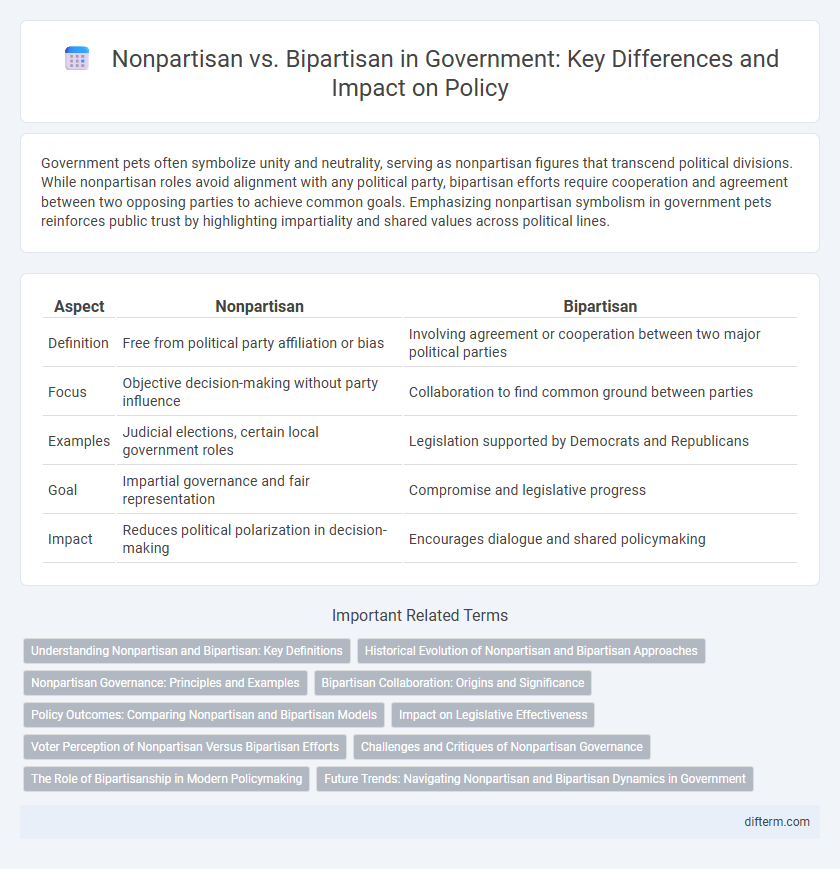Government pets often symbolize unity and neutrality, serving as nonpartisan figures that transcend political divisions. While nonpartisan roles avoid alignment with any political party, bipartisan efforts require cooperation and agreement between two opposing parties to achieve common goals. Emphasizing nonpartisan symbolism in government pets reinforces public trust by highlighting impartiality and shared values across political lines.
Table of Comparison
| Aspect | Nonpartisan | Bipartisan |
|---|---|---|
| Definition | Free from political party affiliation or bias | Involving agreement or cooperation between two major political parties |
| Focus | Objective decision-making without party influence | Collaboration to find common ground between parties |
| Examples | Judicial elections, certain local government roles | Legislation supported by Democrats and Republicans |
| Goal | Impartial governance and fair representation | Compromise and legislative progress |
| Impact | Reduces political polarization in decision-making | Encourages dialogue and shared policymaking |
Understanding Nonpartisan and Bipartisan: Key Definitions
Nonpartisan refers to actions or policies that are not affiliated with or biased toward any political party, ensuring impartiality in government decisions. Bipartisan involves cooperation or agreement between two opposing political parties, typically the major parties, to achieve common legislative goals. Understanding these definitions is crucial for analyzing political collaboration and decision-making processes in government.
Historical Evolution of Nonpartisan and Bipartisan Approaches
Nonpartisan approaches in government have evolved primarily from early 20th-century reforms aimed at reducing political corruption by minimizing party influence in municipal elections. Bipartisan efforts gained prominence during landmark periods such as the New Deal and Civil Rights Movement, when cross-party coalitions addressed national crises and social reforms. The historical evolution of these approaches reflects shifting priorities between fostering political neutrality and achieving collaborative governance in a polarized landscape.
Nonpartisan Governance: Principles and Examples
Nonpartisan governance emphasizes decision-making based on merit and public interest rather than party affiliation, promoting accountability and reducing political polarization. Examples include judicial appointments in some states, where judges are selected through nonpartisan elections or merit-based commissions to ensure impartiality. This approach fosters collaboration and trust within government institutions by prioritizing effective policy outcomes over partisan agendas.
Bipartisan Collaboration: Origins and Significance
Bipartisan collaboration originates from the necessity for political parties to cooperate in order to achieve legislative success and address complex societal issues effectively. This approach fosters policy-making that reflects diverse viewpoints, enhancing the legitimacy and stability of government decisions. Historical examples, such as the Civil Rights Act of 1964, demonstrate the critical role bipartisan efforts play in enacting significant reforms.
Policy Outcomes: Comparing Nonpartisan and Bipartisan Models
Nonpartisan policy models prioritize objective analysis and expert input, reducing partisan bias to create more universally acceptable solutions. Bipartisan approaches emphasize collaboration between parties, often leading to compromises that reflect a broader political consensus but may dilute specific policy goals. Studies show nonpartisan models tend to produce more stable, evidence-based outcomes, while bipartisan frameworks can enhance political feasibility and implementation.
Impact on Legislative Effectiveness
Nonpartisan approaches often enhance legislative effectiveness by fostering open dialogue and reducing ideological polarization among lawmakers. Bipartisan efforts can accelerate policy adoption by uniting major parties around shared goals, but may also result in diluted legislation due to necessary compromises. Studies indicate that nonpartisan frameworks promote more sustainable policy development by emphasizing issue-based collaboration over party loyalty.
Voter Perception of Nonpartisan Versus Bipartisan Efforts
Voter perception of nonpartisan efforts often reflects a preference for unbiased decision-making aimed at the common good, free from party agendas. Bipartisan initiatives, while demonstrating cooperation between major political parties, may still be viewed skeptically by constituents who see them as a compromise that dilutes strong policy stances. Research indicates that nonpartisan approaches can enhance trust and engagement among politically diverse electorates by emphasizing inclusivity and fairness.
Challenges and Critiques of Nonpartisan Governance
Nonpartisan governance often faces challenges due to the lack of clear party accountability, which can lead to voter confusion and reduced electoral engagement. Critics argue that without party labels, voters struggle to assess candidates' policy positions and ideological leanings, complicating informed decision-making. Furthermore, nonpartisan systems may obscure power dynamics and limit transparency in governmental processes, hindering effective oversight.
The Role of Bipartisanship in Modern Policymaking
Bipartisanship plays a crucial role in modern policymaking by fostering collaboration between major political parties to address complex national issues effectively. Unlike nonpartisan efforts that exclude party affiliations, bipartisan initiatives leverage diverse perspectives to create balanced and sustainable solutions, enhancing legislative success and public trust. This cooperative approach is essential for passing comprehensive policies in polarized environments, ensuring government responsiveness and stability.
Future Trends: Navigating Nonpartisan and Bipartisan Dynamics in Government
Future government strategies emphasize a shift towards nonpartisan approaches to enhance policy effectiveness and public trust by minimizing ideological divides. Bipartisan collaboration remains essential for passing comprehensive legislation but increasingly integrates nonpartisan frameworks to address complex societal challenges. Emerging trends highlight the use of data-driven decision-making and inclusive stakeholder engagement to balance nonpartisan neutrality with bipartisan cooperation.
nonpartisan vs bipartisan Infographic

 difterm.com
difterm.com